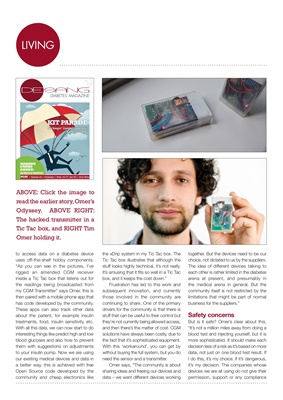
LIVINGLIVING
to access data on a diabetes device
uses off-the-shelf hobby components.
"As you can see in the pictures, I've
rigged an amended CGM receiver
inside a Tic Tac box that listens out for
the readings being broadcasted from
my CGM Transmitter" says Omer, this is
then paired with a mobile phone app that
has code developed by the community.
These apps can also track other data
about the patient, for example insulin
treatments, food, insulin sensitivity, etc.
With all this data, we can now start to do
interesting things like predict high and low
blood glucoses and also how to prevent
them with suggestions on adjustments
to your insulin pump. Now we are using
our existing medical devices and data in
a better way, this is achieved with free
Open Source code developed by the
community and cheap electronics like
the xDrip system in my Tic Tac box. The
Tic Tac box illustrates that although the
stuff looks highly technical, it's not really.
It's amusing that it fits so well in a Tic Tac
box, and it keeps the cost down."
Frustration has led to this work and
subsequent innovation, and currently
those involved in the community are
continuing to share. One of the primary
drivers for the community is that there is
stuff that can be useful to their control but
they're not currently being allowed access,
and then there's the matter of cost. CGM
solutions have always been costly, due to
the fact that it's sophisticated equipment.
With this 'workaround', you can get by
without buying the full system, but you do
need the sensor and a transmitter.
Omer says, "The community is about
sharing ideas and freeing our devices and
data - we want different devices working
ABOVE: Click the image to
read the earlier story, Omer's
Odyssey. RIGHT: The hacked
transmitter in a Tic Tac box,
and Tim Omer holding it.
together. But the devices need to be our
choice, not dictated to us by the suppliers.
The idea of different devices talking to
each other is rather limited in the diabetes
arena at present, and presumably in
the medical arena in general. But the
community itself is not restricted by the
limitations that might be part of normal
business for the suppliers."
Safety concerns
But is it safe? Omer's clear about this,
"It's not a million miles away from doing a
blood test and injecting yourself, but it is
more sophisticated. It should make each
decision less of a risk as it's based on more
data, not just on one blood test result. If
I do this, it's my choice. If it's dangerous,
it's my decision. The companies whose
devices we are all using do not give their
permission, support or any compliance